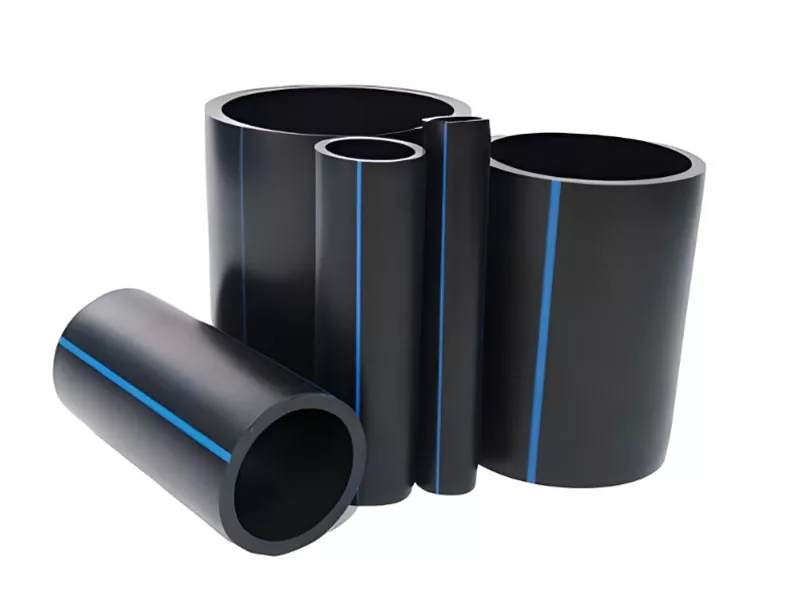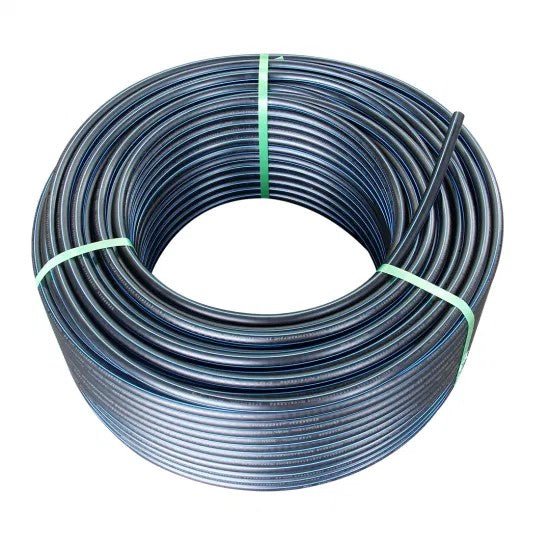Why Texas hdpe pipe manufacturer Is Leading in Advanced Pipe Solutions
Wiki Article
Check Out the Manufacturing Refine Behind High-Quality HDPE Pipeline and Its Applications
The production process of high-grade HDPE pipelines is intricate and systematic. It starts with the option of basic materials that boost efficiency. Following this, ethylene undertakes polymerization to create resin, which is then shaped through extrusion. Quality control is paramount, guaranteeing that the final item satisfies strict standards. However, the journey of HDPE pipelines doesn't end with manufacturing. Their applications throughout various industries reveal a more comprehensive importance worth taking a look at.Recognizing HDPE: Characteristics and Advantages

High-density polyethylene (HDPE) is a versatile polycarbonate known for its durability and resistance to numerous environmental aspects. This product exhibits outstanding tensile strength, making it ideal for requiring applications. Its low-density framework contributes to a lightweight item, assisting in convenience of taking care of and setup. HDPE additionally showcases exceptional resistance to chemicals, which minimizes destruction when subjected to harsh materials.
The material's low moisture absorption better boosts its durability, making it optimal for use in pipelines and storage containers. Furthermore, HDPE is immune to ultraviolet (UV) radiation, guaranteeing that items maintain their honesty also when exposed to sunlight. Its flexibility enables for the production of intricate shapes without jeopardizing stamina. The environmentally friendly nature of HDPE, usually originated from recycled products, contributes to its appeal, promoting sustainable methods in manufacturing. On the whole, these residential properties and benefits make HDPE a recommended choice for various industrial and customer applications.
Basic Material Choice for HDPE Production
The choice of raw products for HDPE manufacturing is necessary to confirm the final product meets the desired requirements and high quality requirements. High-density polyethylene (HDPE) is mostly produced from polymerized ethylene, stemmed from nonrenewable fuel sources such as all-natural gas or unrefined oil. The high quality of these feedstocks greatly affects the mechanical and thermal residential properties of the last HDPE.Additives likewise play a considerable function in improving HDPE's performance, including anti-oxidants, UV stabilizers, and colorants, which improve resilience and resistance to environmental variables. The option process need to consider not just the chemical make-up of the raw products however also their processing characteristics to assure reliable manufacturing.
Furthermore, the sourcing of raw products ought to focus on sustainability and conformity with environmental laws, as accountable practices are vital in today's market. Ultimately, cautious raw material option lays the foundation for producing high-grade HDPE pipes suitable for varied applications.
The Extrusion Process: Shaping HDPE Pipeline
The extrusion process plays an essential function fit HDPE pipelines, beginning with careful product preparation strategies that ensure ideal circulation and consistency. Just as important is the layout of the die, which directly influences the final dimensions and surface top quality of the pipe. Together, these variables contribute greatly to the effectiveness and top quality of HDPE pipe production.Material Prep Work Techniques
Reliable manufacturing of HDPE pipes begins with precise product preparation methods, specifically the extrusion procedure. Throughout this stage, high-density polyethylene material is initial dried to eliminate wetness, making certain ideal flow qualities. The resin is after that fed into the extruder, where it goes through home heating and melting, transforming right into a viscous state. This heating process is thoroughly managed to maintain the material's stability and efficiency. The liquified HDPE is compelled through a die, shaping it right into a constant pipe type. Appropriate temperature level monitoring throughout extrusion is important, as it straight impacts the product's homes and the end product quality. Once shaped, the HDPE pipeline is cooled down and reduced to defined sizes, all set for succeeding handling and applications.Die Design Significance
Accuracy in die design plays a necessary function in the extrusion procedure of HDPE pipelines. The die functions as the last shaping device, straight affecting the pipe's dimensions, wall density, and surface area coating. A properly designed die warranties consistent material flow, lowering defects such as abnormalities and weak points. The geometry of the die have to be maximized to fit the specific residential properties of HDPE, including its viscosity and thermal behavior throughout extrusion. Furthermore, the cooling rate of the material as it goes through the die can considerably impact the pipeline's structural honesty. Investing in advanced die innovation is essential for suppliers aiming to generate top notch HDPE pipes that satisfy market criteria and client assumptions.Quality Assurance Measures in HDPE Manufacturing
Different factors influence the top quality of HDPE pipeline manufacturing, reliable quality control steps are critical to guarantee consistency and integrity in the final product (hdpe pipe suppliers Midland TX). Key top quality control practices include extensive product examination, validating that the raw polyethylene meets well established criteria for pureness and thickness. During the extrusion procedure, parameters such as temperature, pressure, and cooling time are closely kept an eye on to preserve dimensional precision and architectural honestyOn top of that, post-production screening is essential; suppliers typically carry out hydrostatic tests to examine the pipeline's stamina and resistance to pressure. Visual evaluations for surface problems even more boost quality assurance. Certification from relevant criteria companies, like ASTM or ISO, provides an extra layer of trustworthiness. By applying these thorough quality assurance actions, manufacturers can reduce defects, improve efficiency, and make sure that the HDPE pipelines meet the particular needs of different applications, eventually causing client fulfillment and depend on in the product.
Applications of HDPE Pipeline Throughout Industries
HDPE pipelines are used across numerous markets because of their sturdiness and adaptability. In water distribution systems, they guarantee reliable shipment, while in wastewater monitoring, they supply trustworthy options for waste transport. Furthermore, agricultural watering networks gain from HDPE's resistance to corrosion and adaptability, making it an optimal choice for contemporary farming practices.
Water Distribution Solutions
A significant number of industries depend on high-density polyethylene (HDPE) pipes for efficient water circulation systems. Known for their sturdiness and resistance to rust, HDPE pipes are widely utilized in municipal supply of water networks, agricultural irrigation, and industrial applications. Their light-weight nature promotes very Texas hdpe pipe manufacturer easy handling and installment, lowering labor prices and time. Furthermore, HDPE pipes can accommodate various stress degrees, making them appropriate for both low and high-pressure systems. custom hdpe pipe manufacturing Midland TX. The flexibility of the product permits seamless combination right into existing framework, lessening the need for extensive excavation. Furthermore, HDPE's resistance to chemical seeping assurances that the water delivered continues to be risk-free and clean, making it an ideal selection for preserving the top quality of drinkable water throughout different marketsWastewater Management Solutions
Effective water circulation systems likewise pave the method for innovative wastewater monitoring services, where high-density polyethylene (HDPE) pipes play a considerable role. Popular for their sturdiness and resistance to rust, HDPE pipelines are suitable for transferring wastewater in different setups. Their adaptability permits very easy installment in intricate environments, lessening the demand for extensive excavation. In addition, HDPE's smooth indoor surface minimizes friction, enhancing circulation prices and efficiency. These pipes are also resistant to chemical leaching, guaranteeing that pollutants do not compromise the surrounding atmosphere. Industries, communities, and therapy centers significantly rely upon HDPE pipelines for their dependability and long life, making them a recommended selection for modern-day wastewater monitoring systems. This flexibility underscores the crucial significance of HDPE pipelines across countless applications.Agricultural Watering Networks
Agricultural watering networks profit considerably from the usage of high-density polyethylene (HDPE) pipes, which provide reliable and reliable water shipment to crops. HDPE pipes are lightweight, making them easy to carry and set up, while their flexibility enables different configurations in diverse terrains. These pipes show outstanding resistance to deterioration, chemicals, and UV radiation, making sure toughness in rough agricultural environments. Additionally, their smooth interior surface lessens rubbing loss, enhancing water flow and lowering power prices connected with pumping. The long life of HDPE pipelines, commonly going beyond 50 years, adds to reduce maintenance and substitute expenses. Farmers significantly depend on HDPE pipelines to boost irrigation performance and promote sustainable farming practices, ultimately leading to enhanced crop yields and resource preservation.
Future Fads in HDPE Pipeline Innovation
As the demand for sustainable and reliable infrastructure grows, developments in HDPE pipe modern technology are poised to change different markets. Arising patterns include the integration of clever modern technologies, such as sensors and IoT capacities, which promote real-time surveillance of pipe problems, reducing upkeep costs and avoiding leakages. Furthermore, the development of sophisticated manufacturing techniques, such as 3D printing, is making it possible for the manufacturing of facility, tailored pipeline styles that accommodate particular job requirements.The emphasis on recycling and round economic climate methods is driving the development of HDPE pipelines made from recycled products, enhancing sustainability. Boosted jointing methods, such as electro-fusion and mechanical fittings, are also improving installation efficiency and integrity. Ultimately, the growing emphasis on ecological guidelines is pushing suppliers to embrace greener manufacturing processes, guaranteeing that HDPE pipelines not only fulfill industry criteria but also cultivate an even more sustainable future for infrastructure growth.
Frequently Asked Questions
Just How Does HDPE Contrast to Other Plastic Products?
HDPE outmatches many various other plastic materials pertaining to sturdiness, chemical resistance, and flexibility. Its low density and high tensile strength make it suitable for various applications, typically going beyond alternatives in both performance and durability.What Are the Ecological Impacts of HDPE Production?
The environmental influences of HDPE manufacturing consist of greenhouse gas exhausts, power consumption, and prospective pollution from making processes. In addition, improper disposal can lead to soil and water contamination, elevating concerns concerning long-lasting environmental results.Can HDPE Pipeline Be Recycled?
Yes, HDPE pipelines can be recycled. Several centers accept made use of HDPE for handling, transforming it into brand-new products. This reusing adds to sustainability initiatives, minimizing plastic waste while saving sources and energy in the production cycle.What Is the Life Expectancy of HDPE Pipes?

Exactly How Do Temperature Variations Influence HDPE Pipeline Performance?
Temperature variations greatly influence HDPE pipe efficiency, affecting flexibility and strength. Heats can cause softening, while low temperatures might create brittleness, eventually influencing the pipe's toughness and suitability for various applications in varied atmospheres.Report this wiki page